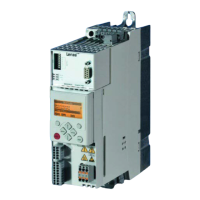8400 StateLine C | Reference manual
Motor control (MCTRL)
Braking operation/brake energy management
228 L Firmware ≤ 11.00 - DMS 8.0 EN - 10/2011
5.11.2.1 Inverter motor brake
This function extension is only available from version 04.00.00!
With this braking method, which can be selected as an alternative in C00175
, the
regenerative energy in the motor is converted as a result of dynamic
acceleration/deceleration with down-ramping of the ramp function generator..
Tip!
If no brake resistor is used, the DC injection brake can also be used for a braking
process in addition to the "inverter motor brake" and "Stopping of the ramp
function generator". DC-injection braking
( 203)
In applications with high mass inertia and long braking times (> 2 s), we
recommend the use of the DC injection brake.
• The DC injection brake provides for an oscillation-minimised braking. The
braking process generally takes more time than the "inverter motor brake"
function with an optimised setting. Moreover, the function is only
recommended for braking to a standstill.
In the following cases we recommend the "inverter motor brake" function:
• For all applications that do not require braking to a standstill (e.g.braking to a
lower speed setpoint) or the braking process can be interrupted by selecting a
new speed setpoint.
• For applications with low mass inertias and a short braking time (< 1 s).
• For all applications where braking should be as quick as possible.
Stop!
• This braking method only works without intervention of a position controller
in the case of speed-controlled applications!
• When the "inverter motor brake" function is used, the Motor load monitoring
(I2xt) is not adapted. If it is braked too frequently, there is a risk of the motor
being thermally overloaded or the motor overload monitoring does not work
properly!
• The "inverter motor brake" function must not be used with vertical conveyors
(hoists) or with active loads!

